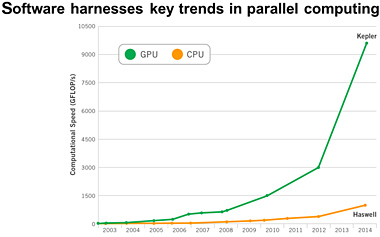Software-Defined Video: A Conversation with Elemental’s Keith Wymbs

Keith Wymbs
ALEXANDRIA, VA.—Two decades ago, it was a struggle to get full-resolution standard-definition video to play smoothly on a computer. Today, a well-equipped modern PC bought at Costco can handle resolutions up to 4K without glitches, yielding inexpensive processing power that simply needs software to do whatever video task you require.
To get some idea of why your next infrastructure upgrade might be more about software than hardware, Broadcast Engineering Extra spoke to Keith Wymbs, chief marketing officer for Elemental Technologies.
Keith has 20 years’ experience in the video, IPTV and telecommunications industries. As chief marketing officer at Elemental, Keith leads the development and implementation of the company’s worldwide marketing strategy and oversees its marketing functions, ranging from product management to outbound communications.
Prior to joining Elemental, Keith led the marketing team of IPTV pioneer Tut Systems (acquired by Motorola), and the business development efforts of Viagate Technologies (acquired by Tut Systems).
BE Extra: What is software defined video and why should we take note of it?
Wymbs: Though fixed-function hardware may continue to provide high performance and good picture quality for specific applications such as standard definition TV over traditional networks, long product lifecycles mean the technology has a low likelihood of keeping pace with market changes. Software running on general purpose processors can now surpass task-specific video processing equipment in terms of both picture quality and performance, while simultaneously adapting to market change.
The professional video industry's #1 source for news, trends and product and tech information. Sign up below.
SDV is an infrastructure-agnostic approach to implementing flexible, scalable and easily upgradable video architectures. Unlike legacy solutions, this advancement allows video providers to deploy software across an optimal combination of dedicated and virtualized resources in both private and public data centers.
Software-defined video provides a new way for media enterprises to engage customers with innovative services such as timeshift and multiscreen TV; offer viewers better video experiences; and reduce capital expenditures. Broadcasters and pay TV operators rolling out premium streaming services can strengthen their competitive position and speed time to market by deploying software-defined video processing architectures as the core of their next-generation infrastructures.
BE Extra: Now that computers can handle HD easily without pricey dedicated graphics systems, it looks like many people are jumping on the 4K bandwagon. Will software defined video always be chasing the complexity of video?
Wymbs: SDV is the only approach that can help media enterprises reduce can handle the demands of an increasing complex video landscape!
Software defined video minimizes technology risk, while maximizing innovation speed and return on investment. For example, the flexibility unique to SDV solutions is vital to the continued expansion of services like 4K and UHD services. SDV solutions used to process MPEG-2 video can offer a more seamless migration path to H.264 and high-efficiency video coding (HEVC/H.265) than dedicated hardware equipment.
Proven in major global live production events, including the Sochi Winter Olympics and 2014 World Cup, software-defined solutions can offer full frame rate 4K/HEVC video processing support.
BE Extra: What are a couple of powerful things that SDV can do today to make the lives of broadcasters easier?
Wymbs: The software-based approach to video processing enables media enterprises to lead and manage the transition to new video codecs such as high-efficiency video coding (HEVC/H.265), advanced audio codecs, advanced color spaces, increased color bit-depth, object-oriented audio specifications, forensic watermarking and new display formats such as 4K Ultra HD.
Video infrastructure complexities and expense are daunting for broadcasters deploying new multiscreen TV and OTT services. SDV mitigates that by unifying head-ends and workflows, while assuring broadcast-grade performance and reliability.
BE Extra: What about the future? As regulations and standards change, how easy is it to update an SDV product to maintain its function?

Computer graphics cards now have considerable processing power that can be harnessed for SDV applications.
Wymbs: A software-defined approach frees video providers from the constraints of dedicated equipment by allowing for the best architecture and processor combination to be used for a particular application, even if that application changes over time. Support for new services and video formats can be integrated seamlessly through simple software upgrades and API integration of third-party software, enabling video providers to immediately respond to changes in consumer demand.
Broadcasters and pay TV operators who choose software-defined video solutions don’t have to wait for new custom video chips to be released to market, they can continually update and enhance their platform in line with increased consumer demand and technology advancements to create new revenue generating video services.
BE Extra: In the new world of video, content is watched on a variety of devices. How does SDV fit into that picture?
Wymbs: With SDV, live-to-VOD features such as nPVR and catch-up TV can be integrated at any time, allowing for even more flexibility and scalability. In dedicated hardware environments, trying to integrate third-party ad messaging or forensic watermarking capabilities means enabling communication with legacy video processing equipment. With its ability to support third-party integrations, a software platform allows all sorts of advanced features and capabilities to be fully integrated into a single unified system.
As the number of consumer viewing devices and video formats continue to multiply, video providers need to keep costs under control and streamline management of their broadcast workflows by consolidating their video processing and delivery systems. On the content delivery side, whether over cable, satellite or the Internet, this means moving to IP-based video technology, including HTML video and adaptive bitrate streaming formats such as HLS and MPEG-DASH, allowing for universal support across multiple types of devices such as smart TVs. IP networking enables distributed storage for greater levels of content backup and redundancy, over internal infrastructure as well as commercial cloud services. The IP standard also allows for more efficient transport of video from broadcast studios, to head-ends and local edge servers for just-in-time packaging of VOD content.
BE Extra: There was a study by Gartner recently about the future of SDV technology. What’s your take on that study?
Wymbs: Gartner is known to identify disruptive technologies that media enterprises need to confidently launch new services and successfully engage with the consumer viewing trends that are transforming the video industry as we’ve known it.
In April 2015, Gartner, one of the world’s most respected IT research firms, issued the first explicit market sizing for the SDV market with a forecast that it will top $10 billion by 2018 in its report titled, “Emerging Technology Analysis: Cloud-Based Solutions Change Video Delivery for CSPs and MSOs Globally.”
This report, authored by Gartner research director Akshay Sharma, concludes that the benefits of software that have pervaded the IT industry are about to have the same impact on the video industry. At Elemental, we feel the Gartner CSP forecast confirms the end of the traditional hardware-based video processing era and that software-defined video’s time has arrived.
That is borne out by the 600-plus content providers who have deployed Elemental software-defined video solutions. Some of these are Comcast, HBO, Turner, Sky and Telstra.
